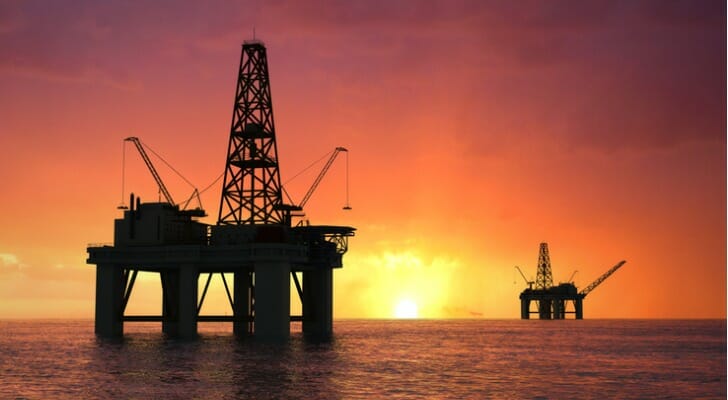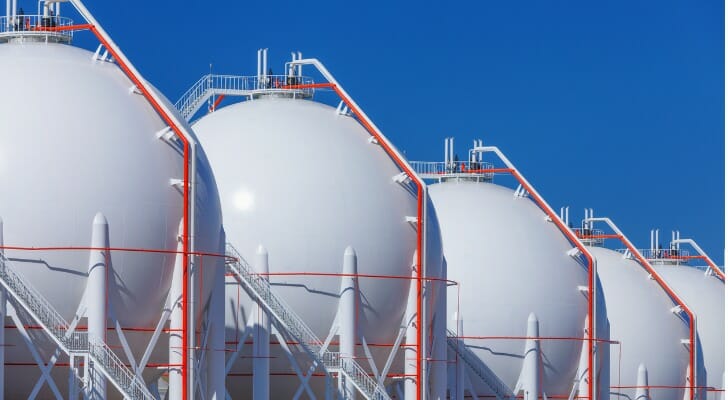 Natural gas investing is a bet on the prospects of the oil and gas energy sector. The industrial and manufacturing sectors use natural gas for a variety of applications, including residential heating and cooling, buses and cars powered by natural gas, electric power generation and a wide variety of manufactured industrial products. Natural gas investing could serve as a hedge against your exposure to the stock market since prices tend to run counter to the market. If you want to add the energy sector to your portfolio, natural gas investing might be something you consider due to the increasing demand for this relatively clean-burning fossil fuel.
Natural gas investing is a bet on the prospects of the oil and gas energy sector. The industrial and manufacturing sectors use natural gas for a variety of applications, including residential heating and cooling, buses and cars powered by natural gas, electric power generation and a wide variety of manufactured industrial products. Natural gas investing could serve as a hedge against your exposure to the stock market since prices tend to run counter to the market. If you want to add the energy sector to your portfolio, natural gas investing might be something you consider due to the increasing demand for this relatively clean-burning fossil fuel.
If you want to include natural gas in your investment portfolio, consider working with a financial advisor.
The Natural Gas Industry
Natural gas is one of the most important fossil fuels in the world. It provides about 18% of the world’s energy needs and, by 2040, it’s estimated that it will provide 25% of energy requirements. The bottom line is that the natural gas industry will grow about 40% by 2040. It is a clean-burning fuel emitting only 50% of the carbon dioxide that is produced by coal.
The United States is the largest producer of natural gas in the world. The demand for natural gas is growing and so is the production. In the past, natural gas was viewed mostly as a way to heat and cool our homes. If there was a particularly brutal winter, there was a big increase in demand, which drove up the prices. Now, due to fracking, this has changed and it’s easier to get the gas out of the ground. Not only can the U.S. meet its own needs for natural gas, but a market for exporting some of the natural gas is developing.
Natural gas, since it is the cleanest burning fossil fuel, competes in the energy market with renewable sources of energy. Natural gas is a valuable complementary source of energy to wind and solar energy. The U.S. is the largest producer of natural gas with huge reserves. the next largest producers are Russia, Iran, Canada and then Qatar.
The market for natural gas is affected by many factors. Weather and economic conditions impact the price and availability of natural gas. China, the major importer of natural gas, is trying hard to grow its economy and it’s going to need a lot of natural gas.
The natural gas market has definite opportunities for investors because natural gas stands beside renewable energy sources as one of the fuels of the future There is a global need for this clean source of energy.
Types of Investments in Natural Gas
There are a number of securities that you can use if you want to invest in natural gas. Here are the main ones:
Stocks
Stocks are a safer way to invest in natural gas than some of the other possible choices. There are five industries in the oil and gas sector, ranging from production to distribution. The betas of the industries making up this sector range from 1.16 to 1.21. The systematic risk of the sector is more than that of the market, but only slightly.
Where you can really see the risk of natural gas stocks, on average, is if you look at their debt-to-equity ratios. Because of the capital-intensive nature of the industry, the debt ratios are high for all the industries in the sector.
However, if you are interested in natural gas stocks, it’s easiest to make stock investments. You can choose different natural gas companies to invest in from within the sector if you are trying to achieve some portfolio diversification.
ETFs
 Because natural gas is one of the most popular commodities to trade, there are a number of exchange-traded funds (ETFs) that are baskets of natural gas securities. You can achieve a slight amount of diversification by investing in an ETF since it is a basket of securities, much like mutual funds. The basket of different securities also insulates you to some extent from the daily fluctuations of the market. ETFs are considered to be fairly safe and reliable for investors. In the ETF space, you have a choice in investing. You can buy ETFs in natural gas that tracks what passes for an index of ETFs. But, you can also buy ETFs made up of the stock of various natural gas companies.
Because natural gas is one of the most popular commodities to trade, there are a number of exchange-traded funds (ETFs) that are baskets of natural gas securities. You can achieve a slight amount of diversification by investing in an ETF since it is a basket of securities, much like mutual funds. The basket of different securities also insulates you to some extent from the daily fluctuations of the market. ETFs are considered to be fairly safe and reliable for investors. In the ETF space, you have a choice in investing. You can buy ETFs in natural gas that tracks what passes for an index of ETFs. But, you can also buy ETFs made up of the stock of various natural gas companies.
Futures
Futures are a more difficult and less safe way to invest in natural gas. Using futures directly, you will buy natural gas today for delivery at a later time at an agreed-upon price. Due to the price fluctuations in the natural gas market, futures are certainly riskier than stocks, but you also have the potential to make a significant return.
Natural Gas Investing and Risk and Return
Before you invest in natural gas, consider these risks. Oil and gas are very sensitive to global upheaval and geopolitical changes, which can cause a change in price. A global recession would almost certainly weaken demand for natural gas. If the price of gas goes up or the cost of making and distributing green sources of energy goes down then the value of natural gas is in doubt.
Geological risk is associated with dwindling supplies of natural gas. It is also the risk that new wells are established and the supply of natural gas at the site is not what it was hoped to be. There are big capital costs that a company incurs in that case.
Supply and demand are affected by geopolitical factors and economic crises. You can’t easily shut down a gas well. You can’t predict an economic pullback due to the 100-year event that was the pandemic.
There are cost risks associated with natural gas exploration. The more regulation, for example, the higher the operational costs of gas wells.
Just like the risks of investing in natural gas are big, the returns can be big as well. There are a lot of factors that have to go well, and good management is definitely a necessity.
The Bottom Line
 Natural gas investing may have reached its moment in the sun. So many new products will rely on natural gas as fuel in the summer. Demand is strong and may continue to be barring any further geopolitical or economic shocks. Chasing high returns also means taking on greater risks. Just remember, the relationship between risk and return when trying to decide on an investment. You have the possibility – but only the possibility – of a higher return if you take on additional risk.
Natural gas investing may have reached its moment in the sun. So many new products will rely on natural gas as fuel in the summer. Demand is strong and may continue to be barring any further geopolitical or economic shocks. Chasing high returns also means taking on greater risks. Just remember, the relationship between risk and return when trying to decide on an investment. You have the possibility – but only the possibility – of a higher return if you take on additional risk.
Tips for Investing
- If you are interested in investing in some of the higher-risk securities, you may want to speak to a financial advisor. Finding one doesn’t have to be hard. Try SmartAsset’s financial advisor matching tool. With a few clicks, you can find an advisor that suits you. Get started now.
- An investment calculator can give you a good idea of how your money will grow. Just plug in the beginning amount, the estimated growth rate, additional contributions and number of years to hold the securities.
Photo credit: ©iStock.com/TebNad, ©iStock.com/tunart, ©iStock.com/georgeclerk